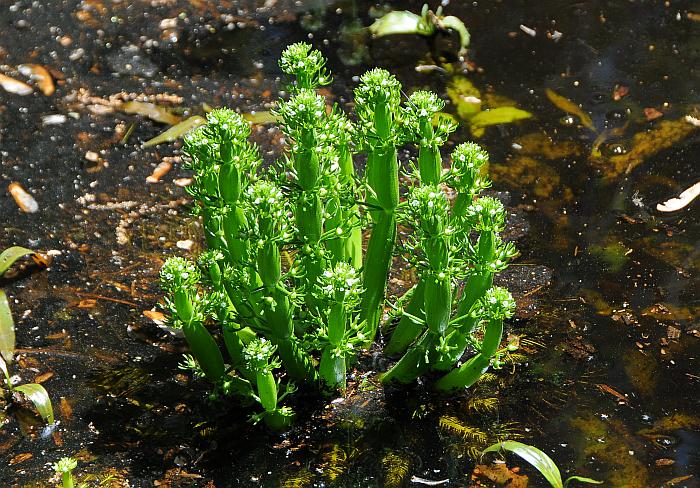Hottonia inflata Elliott
Featherfoil, Water Violet

Native
CC = 10
CW = -5
MOC = 10
SRank = S2
© SRTurner
Hottonia inflata ElliottFeatherfoil, Water Violet | |
 |
Native CC = 10 CW = -5 MOC = 10 SRank = S2 |
© SRTurner |
|
Family - Primulaceae Habit - Biennial, emergent aquatic forb. Stem - Submerged and horizontal, to 90 cm, large diameter and internally spongy.
Leaves - Alternate along submerged stem, clustered in whorl beneath emergent inflorescence. Blades to 10 cm long, sessile or petiolate, pinnately dissected with numerous slender segments.
Inflorescence - Emergent sessile umbels of spikelike racemes. Flowers subtended by bracts, arranged in whorls along strongly inflated axis, with 2-10 flowers per whorl. Inflorescence axes to 30 cm long, 1.5 cm wide, ascending at flowering, floating horizontally at fruiting, hollow, conspicuously segmented at nodes, pubescent with minute glandular and nonglandular hairs. Bracts 3-8 mm long, linear.
Flowers - Actinomorphic, hypogynous, perfect. Flower stalks 3-10 mm long, often with glandular dots or short hairs. Calyces deeply lobed, the lobes 4-9 mm long, 1 mm wide, linear-oblong, with glandular dots or hairs. Corollas 4-5 mm long, white, 5-lobed to below the midpoint, the lobes rounded to bluntly pointed at the tips. Stamens 5, short, the filaments attached in the corolla tube. Ovary unilocular, broadly ovoid to nearly globose, the style short, slender, the stigma club-shaped. Placentation free central.
Fruits - Capsules, 2.0-2.5 mm long, pear-shaped to nearly globose, green, membranous, dehiscing longitudinally by 5 valves. Seeds minute, 0.2-0.3 mm long, oblong in outline, the surface with faint lines.
Flowering - April - July. Habitat - Swamps, sloughs, ponds, ditches. Origin - Native to the U.S. Lookalikes - None. Other info. - This plant gets my nomination for the most bizzarely cool of all of Missouri's flora. It is found in a handful of counties in the southeastern section of the state. It is widely scattered in the eastern part of the continental U.S., ranging from eastern Texas up through Maine, but is it regarded as uncommon nearly everywhere. In Missouri it is a tracked species, with a conservation rating of S2 (Imperiled). Photographs taken at Otter Slough Conservation Area, Stoddard County, MO, 4-22-2019 (SRTurner). Thanks to Stephen Dilks for alerting me to the flowering population. |